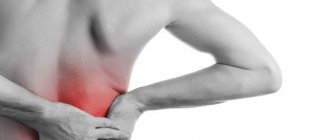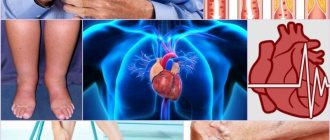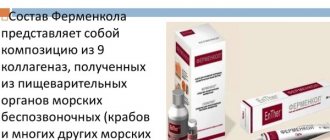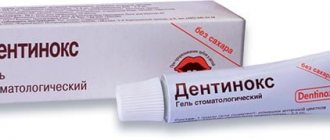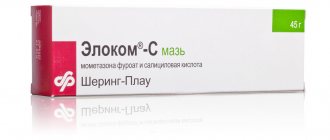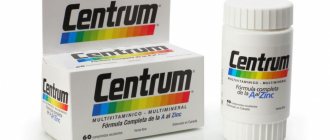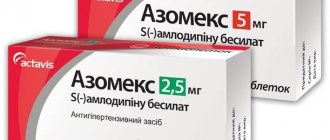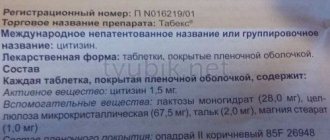From this article you will learn:
- analysis of the composition of Metrogyl-Dent, analogues,
- application diagram and its features,
- reviews of Metrogyl Denta gel, price 2021.
The article was written by a dentist with more than 19 years of experience.
Metrogyl Denta gel is a drug for topical use in the oral cavity that has an antimicrobial effect against pathogenic bacteria that cause gum inflammation. The antimicrobial effect of the drug is ensured by the active components included in its composition - the antibiotic metronidazole and the antiseptic chlorhexidine. In dentistry, this drug is used mainly only for gingivitis, periodontitis, and less often for aphthous stomatitis.
For Metrogyl Denta gel, the instructions for use allow the use of the drug in adults only from 18 years of age (although in the previous instructions the drug was approved from 6 years of age). This change was adopted in 2021, despite the absence of changes in the composition and concentration of active ingredients. However, a product with the same composition - Asepta Gum Balm, which is no longer registered as a “medicine”, but as a “cosmetic product” - has no age restrictions at all.
Metrogil Denta: photo of the new packaging
It must be said that patient reviews of Metrogyl Denta gel are usually quite mediocre, and in our opinion, this drug is not the optimal choice for most of the “indications for use” that are listed in the official instructions. Nevertheless, this drug really works (for example, for gingivitis or mild periodontitis).
Please note that the author of the article has worked as a periodontist for more than 10 years, treating gum inflammation in patients, and therefore our recommendations really work (state-issued documents on the advanced training of the author of the article in the Periodontology program - you can see in the section editorial office).
Indications for use –
The official instructions for Metrogil denta gel contain a fairly wide range of indications for use. This drug can be used:
- with gingivitis,
- with periodontitis,
- in case of inflammation of the mucous membrane under the prosthesis,
- with alveolitis of the socket of an extracted tooth,
- with aphthous stomatitis,
- for cheilitis (inflammation of the lips),
- and even with periodontitis.
But not all indications are optimal.
For example, the drug can actually be used for aphthous stomatitis, the cause of which can be not only allergic reactions, but also one of the types of streptococci (α-hemolytic streptococcus - Streptococcus sangui). Only in the latter case can Metrogyl denta gel be at least somehow effective for aphthous stomatitis, but it also does not anesthetize ulcerations on the mucous membrane. Therefore, for stomatitis, it is optimal to use other drugs that would have an antiseptic, anti-inflammatory, and analgesic effect on the mucous membrane. Also, this gel will not help you with periodontitis. If we are talking about inflammation of the mucous membrane under the denture, the drug will work only if we are talking about bacterial denture stomatitis. If inflammation of the mucous membrane is a manifestation of a toxic reaction to an excess of monomer in the plastic of the denture, this drug will not help.
Metrogyl denta gel – price, composition and analogues
The cost is for 2021. For Metrogyl denta gel the price will be from 280 rubles (per tube of 20 g). The minimum price in social pharmacies is about 250 rubles.
Metrogyl Denta gel: composition
| The content of active substances in 1 g of gel is → metronidazole 10 mg, → chlorhexidine digluconate 0.5 mg (corresponding to a concentration of 0.05%). |
| Excipients - propylene glycol, disodium edetate, carbomer-980, sodium saccharinate, sodium hydroxide, levomenthol, water. |
The composition of the gel is written directly on the packaging -
→ Metrogyl Denta gel: instructions for use (official, PDF)
Composition analysis –
Thus, the drug contains 1% metronidazole and 0.05% chlorhexidine, which have an antimicrobial effect. But don't expect too much from this drug. The fact is that the concentrations of the active components are low enough to obtain a pronounced effect in patients with periodontitis (although such concentrations may be quite sufficient for the treatment of gingivitis). And this opinion is based not only on 10 years of clinical experience with the use of Metrogildent gel, obtained by the author of the article in the treatment of gum inflammation in his patients.
Scientific works will also help us with this (source), which shed light on the effectiveness of different types of antiseptics in the treatment of patients with gum inflammation, and allow us to compare them with each other. So, it turns out that the effectiveness of Chlorhexidine very, very much depends on its concentration. Let's see what this means.
Efficiency of antiseptics (from greatest to least) –
- 0.2% chlorhexidine,
- 0.1% hexetidine (hexoral),
- 0.05% chlorhexidine,
- 0.05% cetylpyridine,
- 0.01% miramistin.
In the scientific work, the link to which we provided above, the effectiveness of antiseptics was analyzed specifically in patients with chronic periodontitis. This form of gum inflammation is distinguished not only by its long-term chronic course, but also by the fact that periodontal pockets form around the teeth during periodontitis. So, if for gingivitis - 0.05-0.12% concentration of chlorhexidine may be quite sufficient to achieve clinical effectiveness, then for periodontitis - only 0.2% chlorhexidine is highly desirable.
Important: the fact is that in a large number of patients with periodontitis, not only bacterial but also fungal flora are sown from periodontal pockets. Clinical studies show that the addition of fungal flora makes pathogenic bacteria less sensitive to antimicrobial agents. This requires the use of higher concentrations of antiseptics and antibiotics, and these concentrations must be effective - including against fungal flora, and not just bacterial ones.
0.2% chlorhexidine meets all these requirements (and this applies not only to gels for gums, but also to antiseptic mouth rinses). Now let's see which patients with periodontitis most often develop an “association” of bacterial and fungal flora (24stoma.ru). For example, if you have long-term chronic inflammation of the gums, if you smoke, if you eat a lot of carbohydrates, if you have concomitant chronic tonsillitis, or have gastrointestinal diseases, or in the past there was at least 1 case of candidiasis (thrush) of any localization .
Conclusions : we recommend using Metrogyl denta gel only in the following situations. Firstly, for catarrhal gingivitis. Secondly, with the mildest initial form of periodontitis, i.e. when the depth of periodontal pockets does not exceed 3.5 mm - and only on the condition that nothing from the list above applies to you (i.e. you do not smoke, you do not have chronic tonsillitis, gastrointestinal diseases, and the list goes on). Moreover, if you are going to use Metrogyl denta, then we recommend doing this only as part of combination therapy, which we will discuss below.
Metrogyl Denta: instructions for use
Next we will tell you how to properly use Metrogil denta as part of complex therapy (together with antiseptic rinses). You probably already realized that this drug will not be very effective as monotherapy, especially when it comes to a form of gum inflammation such as periodontitis.
ANTI-INFLAMMATORY THERAPY SCHEME:
For Metrogyl Denta gel, the instructions for use require that you apply the drug to the gums - 2 times a day (morning and evening - for 7-10 days). Morning treatment is carried out after breakfast and oral hygiene, and it is important in this sequence, and not vice versa. Immediately after brushing your teeth, you should take an antiseptic mouthwash and, without spitting, rinse your mouth with it for 1 minute. For rinsing, 10 ml of solution is enough (this is approximately 1 sip). After rinsing, under no circumstances should you rinse your mouth with water.
If you only have gingivitis, a large list of rinses will suit you (you can read about the main rinses for gum inflammation at this link). But if you have periodontitis, then together with Metrogyl denta gel it is better to use combined products - with 0.2% chlorhexidine or 0.1% hexitedine (which will additionally contain anti-inflammatory components, for example, methyl salicylate). In this case, the best option would be the product – PRESIDENT Antibacterial “Powerful protection against bacteria”, and another good option is “Hexoral” in the form of a solution.
How to apply the gel to the gums - immediately after rinsing, the gel is applied to the gums. It is advisable to pre-dry the gums with a dry gauze pad, because... in this case the gel will stick better. The gel is applied directly only to the gingival margin, which is adjacent to the neck of the teeth (and interdental gingival papillae, respectively). The gel should be applied not only to the gums from the front surface of the teeth, but also from the side of the palate/tongue, although the emphasis should be placed on treating the gums from the front surface of the teeth.
You can apply the gel using your finger or a special thin medical spatula. You need to do this in front of a mirror, with your teeth bared well, so that you can visually see where exactly you are applying the gel. First, the gel is applied to the gums around the lower teeth, and then around the upper teeth. During the application of the gel, as well as after, you may actively salivate. You don’t need to save it or spit it out on purpose, you should swallow it - as you usually do during the day. After applying the gel, we do not recommend drinking for 30 minutes, rinsing your mouth or eating for 2-3 hours.
Important: evening treatment is carried out according to the same scheme (meal → oral hygiene → antiseptic mouth rinse → application of Metrogyl Denta gel to the gums). If you have gingivitis, the duration of therapy is usually 7-8 days, and for periodontitis - 10 days.
special instructions
The drug has an antiseptic effect and disinfects the oral cavity well. However, its use does not replace the need to brush your teeth, which should be done as usual 2 times a day - in the morning and before bed.
If the gel is accidentally ingested (can be swallowed by a child), you should immediately seek emergency help. You may need gastric lavage and appropriate medications.
After the expiration date, the remaining product should not be thrown into the sewer or as garbage on the street. It is placed in a tight bag and then thrown into a trash container.
There is no data on the effect of the gel on the speed of psychomotor reactions. Therefore, it can be used by drivers and other workers whose activities involve the need to make quick decisions.
Gel Metrogyl denta: reviews
It should be noted that Metrogil-denta gum gel was the very first imported gel for gum inflammation, which appeared in Russian pharmacies after the collapse of the USSR. The composition of its active components and their concentrations have not changed since then, and, of course, at the moment it is difficult to consider this gel the optimal choice for the treatment of gum inflammation. Although, as we said above, if you combine it with other means, it is quite possible to get a good result.
The main influence on the effectiveness of using Metrogyl dent will have whether you have previously removed all dental plaque or not. The fact is, they consist of pathogenic bacteria, which are the cause of gum inflammation. Any antiseptic rinses and gels for gums are not capable of disinfecting dental plaque to its entire thickness, i.e. they act only on the most superficial layer of microbial plaque and tartar. And therefore, without removing dental plaque, you will not get a pronounced and lasting effect - even after a full course of using the gel and antiseptic rinses.
Advantages of Metrogyl denta gel –
- good price/tube volume ratio,
- adheres well to the mucous membrane,
- antimicrobial activity is provided immediately due to 2 components - the antibacterial effect of metronidazole and the antiseptic effect of chlorhexidine.
Disadvantages of the drug -
- the concentrations of the active components are slightly lower than the effective therapeutic dosages (this is why the antibiotic gel is over-the-counter - because it is relatively harmless if used uncontrolled),
- the gel does not have a direct anti-inflammatory effect (it reduces inflammation only by suppressing pathogenic bacteria, and not by blocking inflammatory mediators in tissues),
- does not have an analgesic effect,
- and it is also very important that chlorhexidine in Metrogil-dent is not compatible with oral hygiene products that contain sodium lauryl sulfate, because the latter tends to inactivate chlorhexidine (of which there is not too much in the gel anyway).
Important: Scientific research (source) has found that sodium lauryl sulfate (SLS) has the property of inactivating chlorhexidine, which is included in most antiseptic mouthwashes, as well as in many gum gels. This has very important clinical significance, because... mouth rinsing with chlorhexidine solution is prescribed - morning and evening immediately after oral hygiene.
After using toothpaste with SLS, about 2 hours should pass (at least 30 minutes, but this is not enough) for SLS to not affect the effectiveness of chlorhexidine. Considering that the concentration of chlorhexidine in Metrogyl denta gel is already too low, we recommend that you use toothpastes without sodium lauryl sulfate (SLS).
In what cases will Metrogyl Denta not help you?
We have already said above that reviews of Metrogyl Denta gel are often negative, but most often this is due to the fact that many people self-medicate.
There is always only one reason for gum inflammation - insufficient oral hygiene, in which soft microbial plaque accumulates on the teeth, and hard tartar also forms (Fig. 3-4). It is the pathogenic bacteria in the composition of dental plaque/tartar that lead to the development of gum inflammation – gingivitis and periodontitis. Microbial plaque and tartar –
Therefore, before starting treatment, it is correct to carry out ultrasonic cleaning of dental plaque (at the dentist), and only after that carry out a course of treatment at home with antimicrobial and anti-inflammatory agents. Of course, if you start using Metrogil-denta without removing tartar and plaque, you will first certainly notice a temporary improvement (including a decrease in swelling and bleeding of the gums), but this effect will be temporary.
The most important thing here is that such use of the gel leads to the fact that the symptoms of gum inflammation become sluggish and unnoticeable, but the gum inflammation does not disappear anywhere. Sluggish chronic inflammation will gradually lead to the destruction of the attachment of the gingival margin to the necks of the teeth, to the destruction of the bone tissue around the teeth and the inevitable appearance of their mobility. Most patients with problem gums consult a doctor at this stage - when, after prolonged self-medication, they notice that their teeth have become loose. But it is almost impossible to fix such a problem globally at this stage.
Read more about proper gum treatment in the following articles:
- How to properly treat gingivitis
- Effective treatment of periodontitis
Pharmacological properties of the drug Metrogyl denta
Gum gel Metrogyl Denta is a combined antimicrobial drug for the treatment and prevention of certain infectious and inflammatory diseases of the oral cavity. The effectiveness of the drug is due to the presence of two active ingredients in its composition. Metronidazole (1-(β-hydroxyethyl)-2-methyl-5-nitroimidazole) is a nitroimidazole derivative that has antiprotozoal and antibacterial effects against protozoa and anaerobic bacteria that cause periodontitis: Porphyromonas gingivalis, Prevotella intermedia, P. denticola, Fusobacterium fusiformis, Wolinella recta, Treponema spp., Eikenella corrodens, Borrelia vincenti, Bacteroides melaninogenicus, Selenomonas spp . Chlorhexidine (1,6-( para -chlorophenyl-guanido)-hexane) is an antiseptic, active against a wide range of vegetative forms of gram-negative and gram-positive microorganisms, as well as yeast, dermatophytes and lipophilic viruses. It affects bacterial spores only at elevated temperatures. The mechanism of action of metronidazole is due to the biochemical reduction of the 5-nitro group of metronidazole by intracellular transport proteins of anaerobic microorganisms and protozoa. The reduced 5-nitro group of metronidazole interacts with the DNA of microbial cells, inhibiting the synthesis of their nucleic acids, which leads to the death of bacteria. MIC50 m of metronidazole is below 1 μg/ml for anaerobic bacteria that cause periodontitis: Porphyromonas gingivalis, Prevotella intermedia, Fusobacterium nucleatum, Wolinella recta . When applied topically, the concentration of metronidazole in the gum tissue is significantly higher than when taking the drug orally, which minimizes the risk of systemic side effects.
Gel Metrogyl denta: analogues
Metrogyl Denta gel has analogues, and they are quite widely available in pharmacies. A complete analogue is the Dentamet gel (Russian production), which, like Metrogyl Denta, is registered as a “medicine”. Dentamet gel also contains a combination of metronidazole and chlorhexidine, and in exactly the same concentrations. The cost of the drug for a 25 g tube will be from 150 rubles. The gel is produced.
The second option is Asepta Adhesive Gum Balm, which also contains a combination of metronidazole and chlorhexidine. This drug is registered only as a “cosmetic product”, and in addition, it differs slightly in composition. For example, it has a higher concentration of chlorhexidine - 0.1%, and in addition it also contains menthol, as well as peppermint essential oil. The cost of this product is from 240 rubles. And although this drug will be more effective, you need to take into account that the volume of the gel in the tube will be only 10 g.
Interactions of the drug Metrogyl denta
The possibility of interaction with other drugs when Metrogyl Denta is used topically is minimal, but the development of such reactions cannot be completely excluded. Metronidazole may enhance the effect of warfarin and other indirect anticoagulants, which leads to an increase in prothrombin time. When used simultaneously with disulfiram, the toxicity of the drugs increases, which can cause the development of neurological symptoms. The antimicrobial activity of metronidazole is reduced when used simultaneously with phenobarbital and phenytoin due to the accelerated metabolism of metronidazole. Cimetidine slows down the metabolism of metronidazole, which may increase the concentration of the latter in the blood serum.
Metrogyl Denta during pregnancy and lactation -
In the previous version of the instructions for Metrogyl-Dent gel, it was contraindicated for use, but only during the 1st trimester of pregnancy. In the current version of the instructions, it is only “not recommended for use,” but throughout pregnancy (pregnancy is not a complete contraindication for the use of the drug). Thus, Metrogyl denta can still be used during pregnancy, but only in consultation with your doctor.
Regarding breastfeeding, it is best to temporarily stop breastfeeding while using this drug. An interesting point is that if you compare this information with the recommendations of the FDA (U.S. Drug Administration), then according to their recommendations, metronidazole can be taken by pregnant women and is also quite safe when breastfeeding.
Alternatives during pregnancy and breastfeeding - an alternative can be the drug Cholisal, which, in accordance with the manufacturer’s instructions, can be taken throughout pregnancy and the breastfeeding period, but also “with caution.” The term “with caution” means that you should not take the drug unsupervised - it should be prescribed by your dentist, and you should also inform your obstetrician-gynecologist about its prescription.
Contraindications to the use of Metrogyl Denta gel:
- children under 18 years of age,
- allergic reactions to the components of the gel,
- blood diseases,
- diseases of the nervous system.
